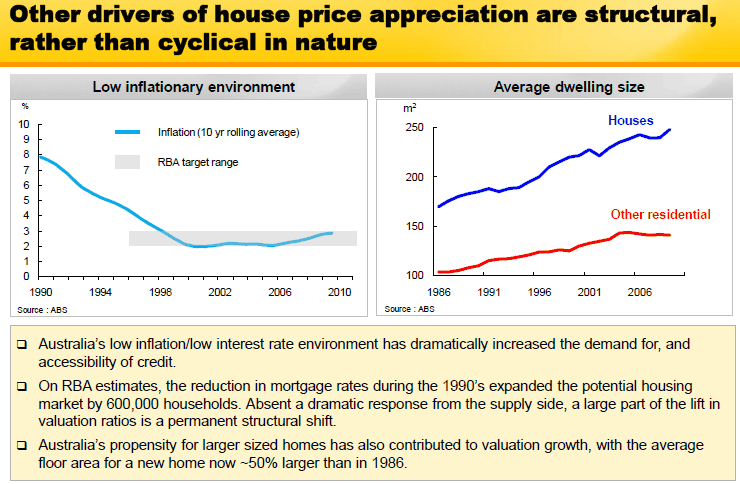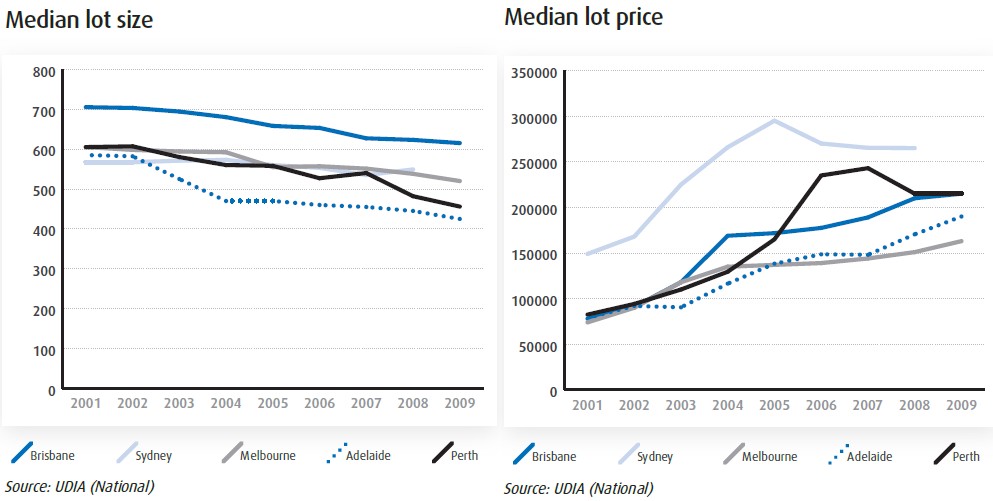
You have heard it before. One of the reasons why Australian home prices are high is because our new houses are supposedly the largest in the world.
For example, consider this slide from last year’s infamous CBA investor presentation:

Or this explanation from HSBC’s Paul Bloxham:
…the quality of the housing stock is high. Australia has the largest dwellings in the world, and they are of high quality. Estimates suggest that the average Australian dwelling is 214 square metres, and real expenditure on new dwellings is now 60 per cent higher than it was 15 years ago, reflecting the increase in both the size and quality of dwellings.
An inconvenient truth that the ‘no bubble crew’ often fail to mention when defending Australian home valuations is the shrinking of block sizes, which has more than compensated for the increase in building size.
An article published today by News Limited, Great Aussie Dream downsizes as house block areas slashed, provides some interesting facts on the shrinkage of new block sizes in Australia; although it completely misses the key reasons why. According to this article, average block sizes have fallen as follows:
- 1950s: 32-36 perches (810sq m-910sq m);
- 1980-90s: 600sq m;
- 2000s: 350 – 450sq m
- 2012: 200sq m – 350sq m
So new block sizes are currently around one-third to one-quarter the size of the 1950s, with most of the shrinkage occurring within the last decade. Of course, average pre-existing blocks are also shrinking in size as urban consolidation takes place and lots are sub-divided.
The article places the blame for the shrinkage on changing household preferences. Apparently, Australian households are now demanding lower maintenance homes and developers are simply ‘meeting the market’.
Unfortunately, the core reason behind the shrinkage – government urban consolidation policies since the early-2000s, including: the implementation of urban growth boundaries (UGBs) around Australia’s cities; minimum density ratios; up-front infrastructure/development charges; and more restrictive zoning – have been completely left out of the article.
These policies have dramatically pushed-up the cost of fringe land, both necessitating the move to smaller block sizes (in order to maintain some semblence of affordability) as well as forcing-up the cost of new and pre-existing homes.
This price escalation can be seen by the following charts from the UDIA, showing block sizes simultaneously shrinking in size and rising in cost – i.e. we are paying more but receiving less in return:

Government planners and green groups would argue that the shrinkage of block size is desirable as it enables a more efficient use of ‘scarce’ land resources and will some how make households less reliant on their cars via more intensive use of public transport. What these groups often fail to concede is the pernicious effects that urban consolidation policies have on housing affordability as well as the perverse outcomes caused by the urban growth constraints themselves.
For example, the building of large houses on tiny blocks, with narrow footpaths and roads (because of the excessive land prices), allows little room to plant trees or veggie gardens. It also means that homes are so close together that many do not contain roof eves or verandas and have poor air flow, thereby requiring greater air conditioning in the summer. The lack of backyards and open space also encourages children to remain inside playing video games and watching TV, which of course uses more energy.
Moreover, the imposition of UGBs often leads to lower income households ‘leapfroging’ the UGB and settling in far flung exurban towns where housing is more affordable. UGBs, therefore, can act to exacerbate urban ‘sprawl’ and increase car reliance and energy usage, which has detrimental distributional impacts in particular on lower socio-economic groups.
I have no problem with the shift to smaller block sizes if this is what new home buyers desire and the shift has been caused by changing preferences. What I do take issue with is spurious planning policies imposed by ignorant governments pushing-up the cost of land/housing, thereby leaving households with little choice in the matter.

